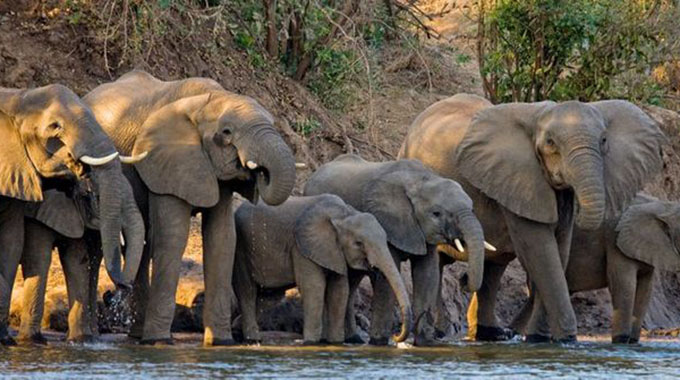Zim elephant population doubles

George Maponga
Masvingo Bureau
The elephant population in Zimbabwe has shot up to unsustainable levels with the head now estimated at over 100 000, more than double the country’s carrying capacity.
Zimbabwe Parks and Wildlife Management Authority (Zimparks) has since raised an alarm over the ballooning numbers that threaten to cause an environmental catastrophe.
Jumbos in the country have been increasing at an annual rate of 5 percent over the past decade.
Zimparks now wants the country to be allowed to depopulate elephant blocks to avert an environmental disaster as the numbers are now more than two times the country’s carrying capacity.
Zimbabwe’s elephant carrying capacity is around 45 000.
However, depopulating local sanctuaries by moving the jumbos to other countries, is restricted under the Convention on International Trade in Endangered Species (CITES).
Elephants are categorised as endangered and trade in the animals or their products is prohibited.
Zimparks spokesperson, Mr Tinashe Farawo, raised the alarm over jumbo numbers in the country.
About 92 percent of elephants in Zimbabwe were domiciled in national parks, around 6 percent under rural district councils and about 2 percent in private sanctuaries.
“Since the last elephant count in 2014 the number of elephants has shot up from 83 000 to over 100 000, which is an average increase of 5 percent annually,” said Mr Farawo.
“Our elephants are now way above the national carrying capacity and this is a recipe for disaster, we are headed for an implosion, a disaster.”
Mr Farawo said the elephant population was now threatening the ecosystem in their habitats.
Some bird species and animals faced extinction owing to destruction of their habitats and breeding turfs by the jumbos.
“We must be allowed to move some of these elephants to other countries that have small numbers or have none at all because an environmental disaster is unfolding, the war to combat climate change is also being negated because the high number of elephants results in destruction of forests.
“There is also an increase in human /wildlife conflict in areas around parks as elephants and other animals forage for food in areas where people inhabit. Every year now we record many cases of people being killed by elephants,” said Mr Farawo.
The Zimparks say wildlife activists should understand that elephants should pay for their upkeep.
He said CITES should be flexible to allow sale of elephants to contain their numbers and also raise money for wildlife management in a Covid-19 ravaged world where revenue from tourism dipped because of limited movements.
Zimparks, Mr Farawo said, had even pegged back its budget by 70 percent this year owing to problems currently engulfing tourism because of Covid-19.
“Our elephants are not endangered species and they must pay for their upkeep the brave men and women who look after wildlife need to be paid, need informs and vehicles and equipment for patrols and when revenue from tourism dries we should be allowed to sale some animals and in this case elephants because their population has shot up,” said Mr Farawo.
In Zimbabwe elephants are in predominate four blocks namely; Sebhungwe near Matusadonha, mid-Zambezi, Hwange-Matetsi and south-east Lowveld including Gonarezhou National Park.







Comments